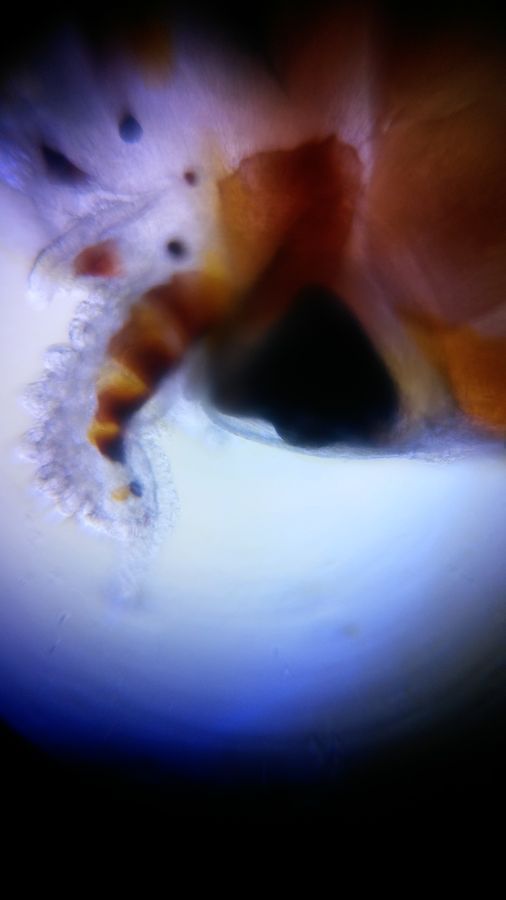Baby squid seen through a Foldscope
 Dec 11, 2015 • 12:06 AM UTC
Dec 11, 2015 • 12:06 AM UTC United States
United States 140x Magnification
140x Magnification Microorganisms
Microorganisms
dianateuthis
Learn about the author...
1posts
1comments
1locations

The above image shows a baby squid viewed through Foldscope. The large black structure in the center of the photo is one of the eyes. Sticking out into the center is an arm, already lined with little suckers protruding from the appendage. The coloration is due to expanded chromatophores, which are the pigment-filled organs that the squid uses to change its skin color. Some chromatophores are retracted – they are the dots visible on the left.
—
When most people think of squid, the aroma of fried batter and the crunchy, chewy experience of eating calamari come to mind. But squid are remarkable animals even when not cooked – there are over 500 documented species in every type of ocean habitat in the world. One species that is readily found off the west coast of the US is the Californian market squid, Doryteuthis opalescens . The behavior, neurophysiology, and ecology of this species is the focus of much of the research done here in the Gilly lab at Hopkins Marine Station of Stanford University. So, naturally, the first thing I wanted to image using a Foldscope would be a baby market squid!
Squid hatchlings about 2 mm in length when they hatch, and they’re totally adorable. To the naked eye, some features are already visible, but looking through the Foldscope, I was able to see little suckers already apparent on the arms! Squid hatchlings typically feed on various small plankton by using the suckers on their arms and tentacles to grab onto prey. Even at the size of a grain of rice, these little cuties are already living up to their reputation as opportunistic (sometimes cannibalistic) carnivorous predators of the ocean.
—
When most people think of squid, the aroma of fried batter and the crunchy, chewy experience of eating calamari come to mind. But squid are remarkable animals even when not cooked – there are over 500 documented species in every type of ocean habitat in the world. One species that is readily found off the west coast of the US is the Californian market squid, Doryteuthis opalescens . The behavior, neurophysiology, and ecology of this species is the focus of much of the research done here in the Gilly lab at Hopkins Marine Station of Stanford University. So, naturally, the first thing I wanted to image using a Foldscope would be a baby market squid!
Squid hatchlings about 2 mm in length when they hatch, and they’re totally adorable. To the naked eye, some features are already visible, but looking through the Foldscope, I was able to see little suckers already apparent on the arms! Squid hatchlings typically feed on various small plankton by using the suckers on their arms and tentacles to grab onto prey. Even at the size of a grain of rice, these little cuties are already living up to their reputation as opportunistic (sometimes cannibalistic) carnivorous predators of the ocean.
Sign in to commentNobody has commented yet... Share your thoughts with the author and start the discussion!
More Posts from dianateuthis
No more posts from this author.